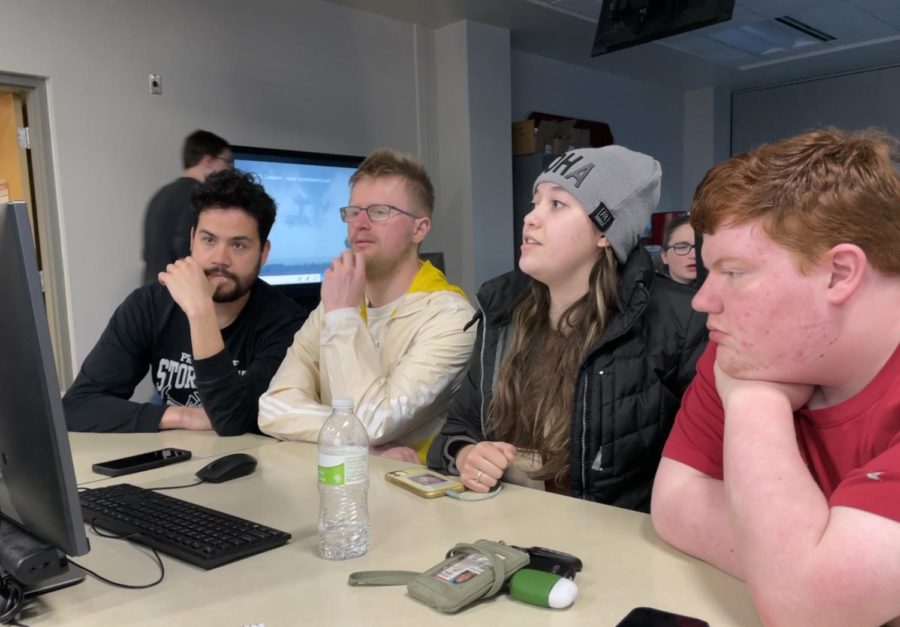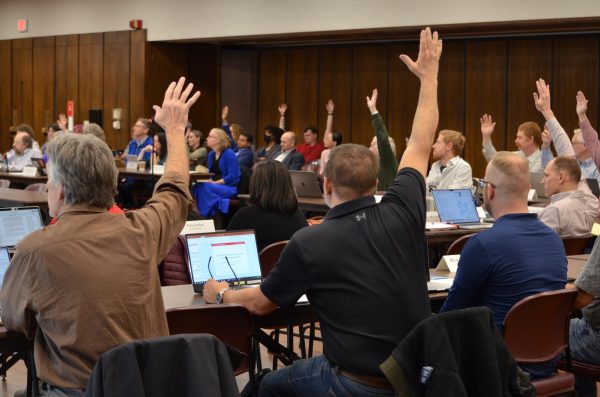ISU American Meteorological Society chapter holds storm-chasing simulation
Tony Manriquez, Mike Sniffin, Adriane Stamer-Fuentes and Andy Powers, all members of the American Meteorological Society, assess their location in the storm chasing simulation.
The American Meteorological Society’s (AMS) Chapter at Iowa State University held its annual storm-chasing simulation in which teams competed against each other on a recreation of a tornado outbreak in Kansas and Oklahoma on May 24, 2011.
AMS Chapter President Mark De Bruin, a senior in meteorology, said students were able to log into computers in the Agronomy Hall computer lab and participate.
“The storm-chasing simulation that we do is a great way for all of the meteorology undergrads to get involved in severe weather and forecasting severe weather,” said De Bruin. “We take radar data from a past severe weather day, say like an outbreak sometime in recent years, and we take all that radar data, and we speed it up and make it look like it’s happening in real-time.”
The evening began with Hunter Fowkes, a junior in meteorology, presenting a forecast which began four days before the simulation. The presentation featured forecast discussions from the National Weather Service’s Storm Prediction Center (SPC).
In the days leading up to May 24, 2011, forecasters said a tornado outbreak was to be expected in the central Oklahoma and south Kansas areas.
Fowkes also showed an atmospheric sounding from the University of Oklahoma taken at 7 a.m. on the day of the outbreak, which he said was “pretty ridiculous,” volatile and a solid environment for tornadoes.
At noon on May 24, 2011, the SPC issued a 45% tornado probability of a tornado within 25 miles of a point in most of central Oklahoma. When shown this, the people in the computer lab oo-ed and ah-ed, with some laughing in disbelief.
“All of the students can pull that radar up on their own computers, and they get to decide where they want to start their team off, and then they get to decide how they’re going to navigate around that storm in order to follow along with it,” De Bruin said.
Teams got points based on their proximity and view of tornadoes to be able to see them, and they could lose points, for example, by getting caught in a hail core. If a team were to get too close to a tornado, they would be “killed” by it and eliminated.
Each team had a budget of $300, which they had to use to refuel and possibly pay off speeding tickets.
Adriane Stamer-Fuentes, a sophomore in meteorology, was on team M.A.T.A. which chose to start in Pawnee, Oklahoma. Their methodology was to be in a big enough city to refuel their chosen vehicle, a truck, and be in the 45% probability area.
“We are team M.A.T.A., our initials, it’s Mike, Adriane, Tony and Andy [and] it means kill in Spanish,” Stamer-Fuentes said. “We’re killing all the competition.”
Team M.A.T.A. comprised of Stamer-Fuentes, Andy Powers, a sophomore in meteorology, and seniors in meteorology Mike Sniffin and Tony Manriquez. Notably, Stamer-Fuentes was a part of the winning team for last year’s simulation.
Through nearly two and half hours, the teams attempted to avoid getting stuck in the mud, speeding tickets, running out of fuel, hail cores and other obstacles. When a team ran into a hail core, Fowkes and the other people running the simulation dropped plastic Easter eggs on them.
Team M.A.T.A.’s route near El Reno, Oklahoma, was able to avoid hail cores, but they also avoided seeing many tornadoes.
“We didn’t get hail cored, we didn’t get stuck in the mud and we got within a mile [of a tornado] and lived,” Powers said.
Ultimately team M.A.T.A. did not “kill their competition” and finished in sixth place. Despite this, they enjoyed the experience and were glad they did not “die” and avoided speeding tickets.
“This [is] at least a nice safe spot because when the adrenaline starts hitting you when you go out like it gets crazy, you get so many roller coaster emotions with it,” Manriquez said. “It feels like we’re doing it without actually having to worry about being in the middle of nasty inclement weather.”
Your donation will support the student journalists of the Iowa State Daily. Your contribution will allow us to purchase equipment, send our student journalists to conferences and off-set their cost of living so they can continue to do best-in-the-nation work at the Iowa State Daily.













